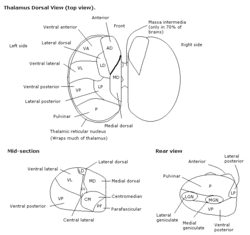Thalamic reticular nucleus
The thalamic reticular nucleus is part of the ventral thalamus that forms a capsule around the thalamus laterally. However, recent evidence from mice and fish question this statement and define it as dorsal thalamic structure.[1][2] It is separated from the thalamus by the external medullary lamina. Reticular cells are GABAergic, and have discoid dendritic arbors in the plane of the nucleus.
| Thalamic reticular nucleus | |
|---|---|
 Thalamus | |
| Details | |
| Part of | Thalamus |
| Identifiers | |
| Latin | nucleus reticularis thalami |
| NeuroNames | 365 |
| NeuroLex ID | birnlex_1721 |
| Anatomical terms of neuroanatomy | |
Thalamic Reticular Nucleus is variously abbreviated TRN, RTN, NRT, and RT.
Input and output
The thalamic reticular nucleus receives input from the cerebral cortex and dorsal thalamic nuclei. Most input comes from collaterals of fibers passing through the thalamic reticular nucleus. Primary thalamic reticular nucleus efferent fibers project to dorsal thalamic nuclei, but never to the cerebral cortex. This is the only thalamic nucleus that does not project to the cerebral cortex, instead it modulates the information from other nuclei in the thalamus. Its function is modulatory on signals going through thalamus (and the reticular nucleus).
The thalamic reticular nucleus receives massive projections from the external segment of the Globus Pallidus, thought to play a part in disinhibition of thalamic cells, which is essential for initiation of movement (Parent and Hazrati, 1995)
It has been suggested that the reticular nucleus receives afferent input from the reticular formation and in turn projects to the other thalamic nuclei, regulating the flow of information through these to the cortex. There is debate over the presence of distinct sectors within the nucleus that each correspond to a different sensory or cognitive modality.
For original connectivity anatomy see Jones 1975.[3]
For discussion of mapping and cross modality pathways see Crabtree 2002.[4]
References
- Scholpp S, Delogu A, Gilthorpe J, Peukert D, Schindler S, Lumsden A (November 2009). "Her6 regulates the neurogenetic gradient and neuronal identity in the thalamus". Proc. Natl. Acad. Sci. USA. 106 (47): 19895–900. doi:10.1073/pnas.0910894106. PMC 2775703. PMID 19903880.
- Vue TY, Bluske K, Alishahi A, et al. (April 2009). "Sonic hedgehog signaling controls thalamic progenitor identity and nuclei specification in mice". J. Neurosci. 29 (14): 4484–97. doi:10.1523/JNEUROSCI.0656-09.2009. PMC 2718849. PMID 19357274.
- Jones E (1975). "Some aspects of the organization of the thalamic reticular complex". J. Comp. Neurol. 162 (3): 285–308. doi:10.1002/cne.901620302. PMID 1150923.
- Crabtree JW, Isaac JT (October 2002). "New intrathalamic pathways allowing modality-related and cross-modality switching in the dorsal thalamus". J. Neurosci. 22 (19): 8754–61. doi:10.1523/JNEUROSCI.22-19-08754.2002. PMC 6757787. PMID 12351751.
Further reading
- Hestrin, Shaul (2011). "The strength of electrical synapses". Science. 334 (6054): 315–316. doi:10.1126/science.1213894. PMC 4458844. PMID 22021844.
- Haas, Julie S.; Zavala, Baltazar; Landisman, Carole E. (2011). "Activity-dependent long-term depression of electrical synapses". Science. 334 (6054): 389–393. doi:10.1126/science.1207502. PMID 22021860. Retrieved 2011-10-22.